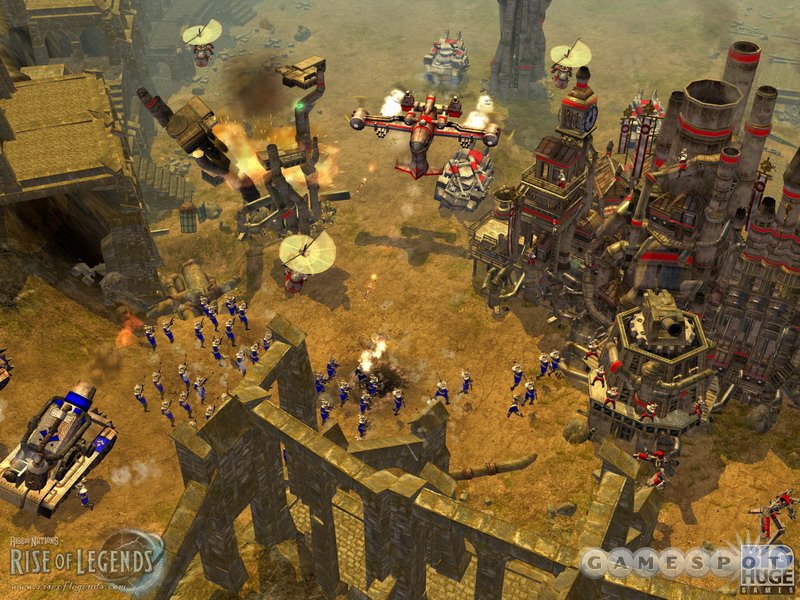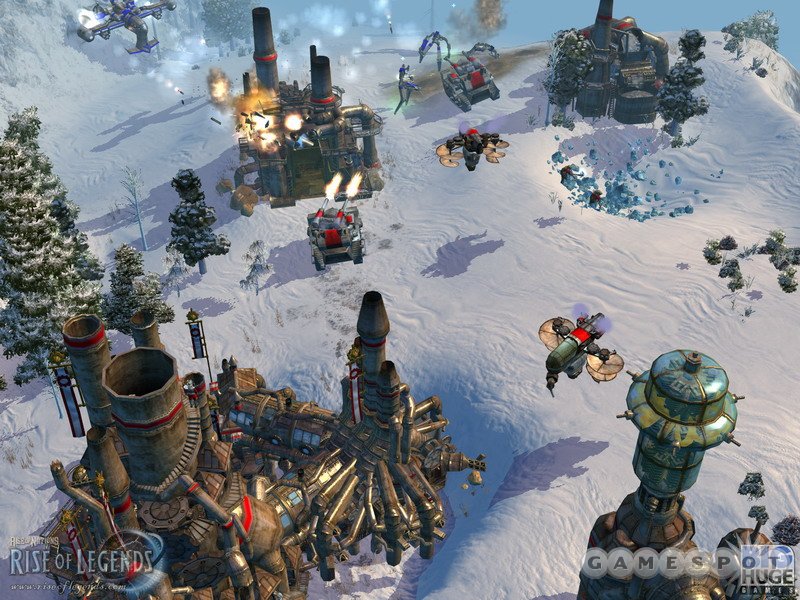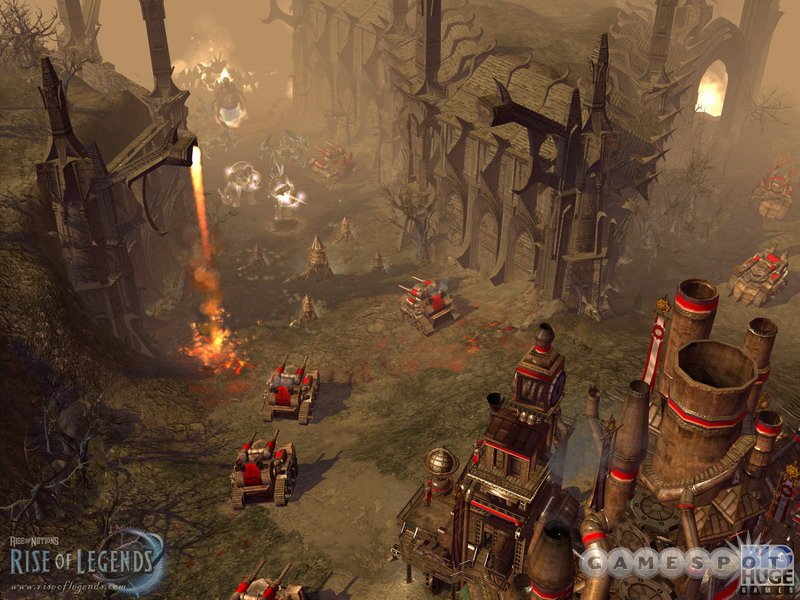Rise of Nations: Rise of Legends Designer Diary #3 - The Da Vinci Coding
Art director Dave Inscore explains how Leonardo da Vinci helped inspire a large section of Rise of Legends.
Big Huge Games' first game was the award-winning Rise of Nations, a game that could best be described as Civilization in real time. So it caught a lot of people by surprise that the company announced a fantasy-themed strategy game as its sophomore effort. Rise of Nations: Rise of Legends isn't a sequel, but rather, it's a follow-up that takes many of the acclaimed gameplay conventions from Rise of Nations and combines them with a new fantasy universe. And when we mean fantasy, we don't mean the J.R.R. Tolkien-style of fantasy, with haughty elves, surly dwarves, and sassy peasants. But we'll let Dave Inscore, Big Huge Games' art director, explain.

The Da Vinci Coding
Dave InscoreArt Director, Big Huge Games
To most artists, there is nothing more exciting and, at the same time, more intimidating than a blank canvas. During the early days of Rise of Legends, we were faced with that very thing. Game designers and writers were working out story detail and world background. Our artists charged forward and churned out blue-sky concepts in hopes of informing and inspiring the world creation. It was during those early days that I was struck by how strong a pull the familiar can be. Many early concepts covered the traditional range of Tolkien-esque, Dungeons & Dragons fantasy styles, i.e. knights, orcs, elves, ogres, and so on. They just weren't fresh and exciting.
The team looked to a true genius for help: Leonardo da Vinci. An idea surfaced for drawing inspiration from da Vinci's vast, brilliant library of work. Taking it even further, the team proposed to have his work form the backbone of an entire race in the game. Programmers, designers, and especially artists all nodded heads in agreement. It was just the creative spark that was needed in order to satisfy the desire to push beyond "traditional" fantasy.
The art team immediately began rifling through all the da Vinci references. After wading past extensive text and study on such icons as "Mona Lisa," "The Last Supper," and "Vetruvian Man," we focused our gaze on his fascinating mechanical sketches. Leonardo was a tremendous illustrator who used his skills to draw mechanical blueprints with extreme clarity. He designed numerous weapons, such as missiles, grenades, mortars, multibarreled machine guns, and even a modern-style tank. This was a treasure trove of reference material just waiting to be exhumed and recast into our own designs.
Our first attempt to transform a da Vinci mechanical sketch into a unit design was a resounding success. The sketch was a flying machine powered by a large rotating airscrew. We used the rotating airscrew as the basis for our Vinci scout helicopter's rotor blade (Note: We now had not only decided to borrow from da Vinci's work, but also felt that honoring his genius via the civilization's moniker was the courteous and proper approach). We were quite pleased and excited with the final concept. The excitement grew to a fevered pitch when our team of skilled animators unveiled its work. The scout helicopter was fully operational, a fascinating mix of ungainly flight behavior--pipes rattled, steam randomly vented--topped off with a da Vinci-esque airscrew somehow keeping it harrowingly airborne. It had the look of a brilliant but untested invention rushed off the assembly line in a time of urgent military need. Fresh and exciting indeed. Game on!

While unit designs were falling into place, the Vinci architectural look and feel was heading down a different creative path. We wanted to solve the "city should look like a city" problem, which we never quite resolved to our satisfaction in Rise of Nations. To do this, we came up with the districts system. In order to expand your city center into a larger and more powerful city, you must add individual districts. Think of it as adding components to a larger invention. Our early sketches combined large gears with a blend of more traditional medieval European and Italian Renaissance architecture.
After finalizing a number of concepts, we charged forward with production and gathered around to view our handywork in-game. The gears looked fantastic! Their clockwork movements were lively and engaging, breathing life into the structures. Furthermore, they acted as visual glue that brought the separate districts together into a massive, bustling, awe-inspiring metropolis. However, we weren't quite there just yet. The more "traditional" aspects of the design, namely the medieval European and Italian Renaissance architectural elements, hadn't been as successful. In many ways, the large towers and rock facades seemed to draw us back to the more iconic fantasy styles we had been so carefully avoiding with our unit work. We needed to shift gears, or rather, we needed to keep the gears and lose all architectural elements that reminded us of standard fantasy fare. It was difficult to realize that we hadn't lived up to our internal standards of excellence. We forced ourselves to toss out assets that took months of precious production time and hit the reset button on the Vinci architectural vision.
In our time of creative need, we once again turned to the work of Leonardo for inspiration. During his lifetime, electricity had yet to be harnessed. Water served as the ultimate source of power. He studied all forms of the great H20--liquid, steam, and ice--and came up with all kinds of ingenious ways in which to utilize it. Among his plans were various waterwheels, a device to measure humidity, and a steam-powered cannon. The steam-related work, in particular, piqued our interest. We decided to replace all aspects of the 15th century architecture with more 19th century Industrial Revolution apparatuses. Massive smokestacks littered the Vinci skylines. Random bursts of steam vented throughout. Metal pipes and giant gears glued it all together. The end result was a striking ensemble of industrial magnificence that reminded us of no fantasy world we had seen before. Once again, game on!

At Big Huge, we love fantasy. However, we, along with what we believe to be a majority of other gamers, are tired of the standard formulaic fare of orcs, elves, and dwarves. Looking back on our experience with the Vinci, we feel that our successes centered on those times when we were able to set aside our preexisting notions of fantasy to allow our more experimental side to take over. We've constructed a unique world that will deliver an experience that is entirely new and engaging. The Vinci, with their inventor heroes and impossible machines, have us excited for fantasy all over again.
Got a news tip or want to contact us directly? Email news@gamespot.com
Join the conversation